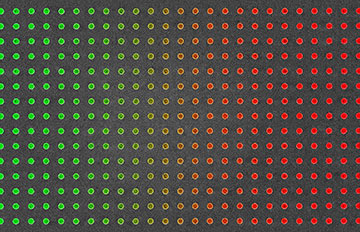
The sensor is based on changes in surface plasmon resonance, which occurs when arrays of metal nanoparticles confine light and bring about distinct wavelength shifts. The shift in color indicates the change in the amount of hydrogen in the surroundings. [Image: Chalmers University of Technology | Y. Strandqvist]
Hydrogen could prove a key energy source for the future. When hydrogen combusts, the only byproduct is water molecules, avoiding carbon emissions. Hydrogen molecules also possess a high energy density—120 MJ/kg—almost three times that of gasoline.
Yet using hydrogen can be risky. When even a small amount leaks into the air, the slightest of sparks can ignite resulting hydrogen-air mixture. Hydrogen can also penetrate almost anything, including a sheet of steel, because it is the lightest and the smallest of molecules. Because of these characteristics, detecting leaks will be vital for any “hydrogen economy” aiming to subsitute the light gas for fossil fuels.
Now, researchers in Sweden and the Netherlands have unveiled what they believe is the most sensitive optical hydrogen sensor ever been reported (Nat. Commun. doi: 10.1038/s41467-022-33466-8). The researchers used an inverse design method to optimize the device—a plasmonic metasurface based on a periodic array of palladium nanoparticles.
With a rising need for hydrogen sensors resulting from expanded reach of hydrogen-related technologies, the team hopes that its latest work will contribute to the development of next-generation devices that could meet the performance demands, says one of the team leads, Christoph Langhammer at the Chalmers University of Technology, Sweden.
Broad peaks, low sensitivity
Optical hydrogen sensors offer a number of advantages over electrical ones, the most notable being that the optical versions can avoid the risks of explosions caused by electric sparks. While electrical sensors require measurement circuits to be present in the monitored area, optical devices can eliminate that need by delivering their signals from far away. Another benefit is that optical sensors can function in areas with heavy chemical usage, which could easily corrode electric circuits.
However, one big drawback of optical sensors is that they are less sensitive than electrical ones. Plasmonic hydrogen sensors, in particular, sense hydrogen by detecting shifts in the localized surface plasmon resonance (LSPR) spectra of palladium nanoparticles. The change is caused by palladium hydride, formed when hydrogen molecules split into hydrogen atoms and then infiltrate the metal lattice.

Christoph Langhammer. [Image: Chalmers University of Technology | A.-L. Lundqvist]
Unfortunately, due to the optically lossy nature of palladium, its LSPR spectral peaks tend to be broad. Consequently, even state-of-the-art plasmonic and other optical sensors only have single-digit parts-per-million (ppm) sensitivity, while electrical sensors have been reported to detect hydrogen on a parts-per-billion (ppb) level.
Inversely designing the sensor
To narrow the peak widths and improve the sensitivity of plasmonic hydrogen sensors, the researchers—led by Langhammer, Jaime Gómez Rivas at the Eindhoven University of Technology, Netherlands, and Andrea Baldi at the Vrije Universiteit Amsterdam, Netherlands—decided to explore 2D periodic arrays of palladium nanoparticles instead of the quasi-random arrangement that they had been using. With the orderly geometry, they observed narrower features that emerge from nanoparticles’ collective surface lattice resonances (SLRs), which stem from the hybridization of the individual particles’ LSPRs and the constructive in-plane diffraction of the incoming light.
The researchers then deployed an inverse-design optimization algorithm, swarm optimization, to the palladium nanoparticle arrays. What they found during the design optimization process was that they needed to strike a balance between a large optical response and narrow spectral features.
When they manufactured the sensor with the optimized design and tested it using hydrogen gas and synthetic air (a mixture of nitrogen and oxygen gases), the researchers discovered that their sensor demonstrated a hydrogen detection limit of 250 ppb—making it the most sensitive optical hydrogen sensor reported. Langhammer says that, ultimately, the inverse-design process made the process of designing the sensor a lot more efficient; without it, there would have been a lot of trial and error.
Lab to market
Langhammer says that “as one very important enabler of the large-scale deployment of hydrogen-related technologies, hydrogen sensors will be required everywhere.” And he thinks the plasmonic technology has many attractive traits for this application.
While the latest sensor still needs to be tested in real-life conditions—for example, with real air, which has more molecular species than nitrogen and oxygen—Langhammer says he and his colleagues have been collaborating with a sensor company in Gothenburg, Sweden, to bring the technology to the market. “I think it has potential, but it is a big task to take something from the lab scale to reality,” he adds.

